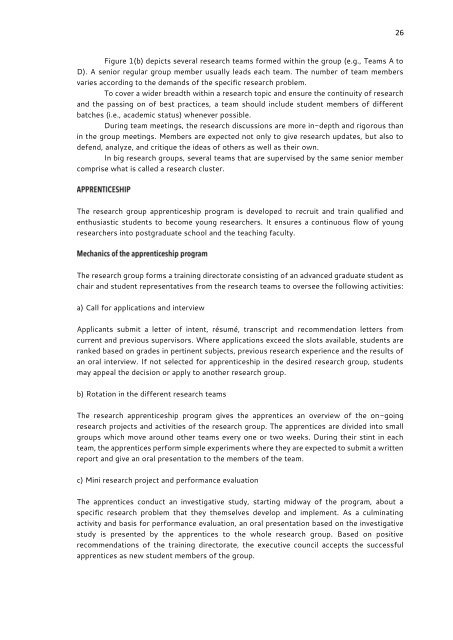A up RESEARCH GUIDEBOOK
33DSJ3
33DSJ3
Create successful ePaper yourself
Turn your PDF publications into a flip-book with our unique Google optimized e-Paper software.
26<br />
Figure 1(b) depicts several research teams formed within the gro<strong>up</strong> (e.g., Teams A to<br />
D). A senior regular gro<strong>up</strong> member usually leads each team. The number of team members<br />
varies according to the demands of the specific research problem.<br />
To cover a wider breadth within a research topic and ensure the continuity of research<br />
and the passing on of best practices, a team should include student members of different<br />
batches (i.e., academic status) whenever possible.<br />
During team meetings, the research discussions are more in-depth and rigorous than<br />
in the gro<strong>up</strong> meetings. Members are expected not only to give research <strong>up</strong>dates, but also to<br />
defend, analyze, and critique the ideas of others as well as their own.<br />
In big research gro<strong>up</strong>s, several teams that are s<strong>up</strong>ervised by the same senior member<br />
comprise what is called a research cluster.<br />
The research gro<strong>up</strong> apprenticeship program is developed to recruit and train qualified and<br />
enthusiastic students to become young researchers. It ensures a continuous flow of young<br />
researchers into postgraduate school and the teaching faculty.<br />
The research gro<strong>up</strong> forms a training directorate consisting of an advanced graduate student as<br />
chair and student representatives from the research teams to oversee the following activities:<br />
a) Call for applications and interview<br />
Applicants submit a letter of intent, résumé, transcript and recommendation letters from<br />
current and previous s<strong>up</strong>ervisors. Where applications exceed the slots available, students are<br />
ranked based on grades in pertinent subjects, previous research experience and the results of<br />
an oral interview. If not selected for apprenticeship in the desired research gro<strong>up</strong>, students<br />
may appeal the decision or apply to another research gro<strong>up</strong>.<br />
b) Rotation in the different research teams<br />
The research apprenticeship program gives the apprentices an overview of the on-going<br />
research projects and activities of the research gro<strong>up</strong>. The apprentices are divided into small<br />
gro<strong>up</strong>s which move around other teams every one or two weeks. During their stint in each<br />
team, the apprentices perform simple experiments where they are expected to submit a written<br />
report and give an oral presentation to the members of the team.<br />
c) Mini research project and performance evaluation<br />
The apprentices conduct an investigative study, starting midway of the program, about a<br />
specific research problem that they themselves develop and implement. As a culminating<br />
activity and basis for performance evaluation, an oral presentation based on the investigative<br />
study is presented by the apprentices to the whole research gro<strong>up</strong>. Based on positive<br />
recommendations of the training directorate, the executive council accepts the successful<br />
apprentices as new student members of the gro<strong>up</strong>.




